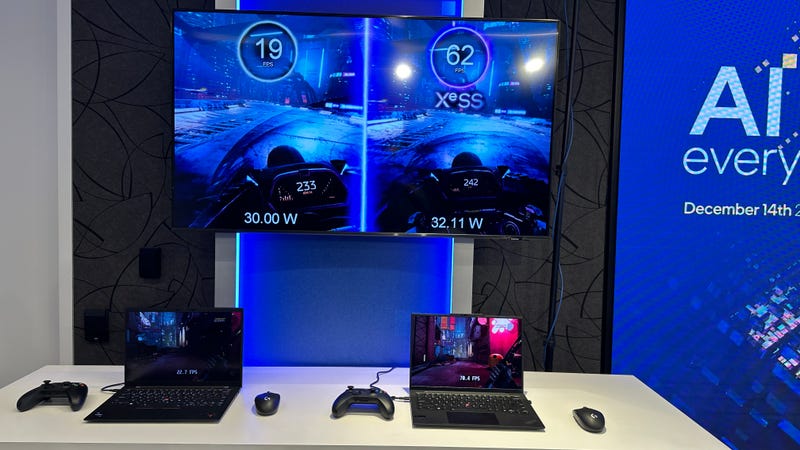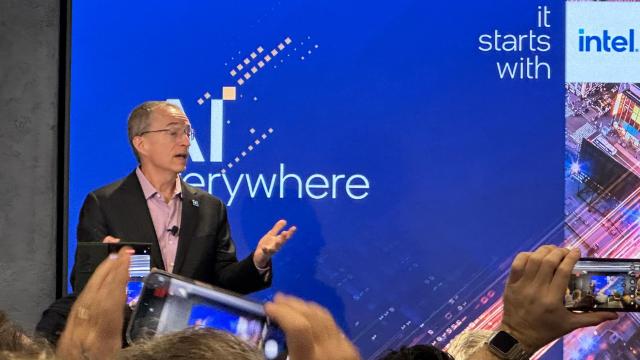Intel’s latest chips boast big performance gains, but never mind any of that. What would be a normal annual chip refresh announcement from one of the world’s biggest silicon developers has put the biggest emphasis yet on onboard PC AI, with the latest Intel Core Ultra line as part of the current Meteor Lake chipsets promising drastic performance boosts in the integrated GPU while splitting other intensive tasks on the new neural processing unit, the NPU.
First off, the newly announced Intel Core Ultra 7 165H sports 16 cores and 22 threads that can support up to 5.1 GHz frequency. The chip is supposed to offer 11% better multi-threaded performance compared to other ultrathin chips, such as the company’s own Intel Core i7-1370P, the AMD Ryzen 7 7850U, and the Qualcomm Snapdragon 8cx Gen 3.
Intel claimed the Intel Core Ultra 7 165H used 25% less power than the Intel Core i7-1370P when tested on Netflix video playback. Even with that, the company claimed that an Asus Zenbook 14 running the Ultra 7 155H beat out similar laptops with an i7-1360P and AMD Ryzen 7 7840U in editing on Adobe Premiere and Lightroom. These supposed power reductions were supported by leaked benchmarks before the new chips were officially announced, though perhaps not as dramatic as was suggested.
There’s also a slightly less powerful Ultra 5 155H with the same number of cores but clocks out at 4.8 GHz speeds and has a slightly worse max frequency. Both chipsets use the integrated Arc GPUs for graphics, and Intel is promising you’ll get a sizable upgrade in graphics power with these new chips. The company claims users should get 10% faster graphics performance on average than the AMD Ryzen 7850U at 28W, tested across a range of games from Dying Light 2 to Marvel’s Spider-Man.
Intel Expects 100 Million ‘AI PCs’ by 2025

Intel isn’t immune to Silicon Valley’s new obsession with AI. Inevitably, whatever next generation of chips the company was going to create would be like a fork with several prongs bent in such a way to tout the chip’s marginal improvements toward processing AI. The company said these new chips are optimized to power AI models. Part of that is the Intel AI Boost, which is the integrated neural processor engine for Intel chips. The other is the NPU, which is meant to sustain AI workloads so the processing doesn’t eat into the battery life.
At its AI Everywhere event Thursday, Intel CEO Pat Gelsinger held the new Ultra 7 chip aloft, like the first of what is hopefully many gold nuggets panned from the nearby stream. He declared this was the dawn of the “AI PC.” What does that mean exactly? In a hardware sense, it means every chip the company makes moving forward will have a dedicated NPU. As far as what this means for actual consumers, Gelsinger puts the emphasis on whoever ends up making more AI applications. The company said there are already 100 independent software vendors making more than 300 AI-accelerated features made to work on the Ultra processors. Inevitably, most of these are mere enhancements to existing services or are
“I believe we’re going to see more benefits already next year,” the Intel CEO said, adding that this could be a process lasting for the next decade until the point that AI is as “ambient” as the internet itself. That doesn’t mean Intel won’t immediately hop on the AI gravy train. The company said it plans to have its chips inside 100 million “AI PCs” by 2025.
Just how AI-capable are the new Ultra Series chips?

Just a few months ago, Qualcomm was also hitting hard on the onboard AI capabilities of its upcoming Snapdragon 8 Gen 3 series. A quick shorthand for PC performance relies on a few things. First, you look at the CPU, GPU, and memory. With these new chips, Intel and Qualcomm are essentially declaring that the next big benchmark across mobile devices will be the NPU focused solely on AI-related tasks.
Intel showed Gizmodo how Zoom’s background blurring feature can be handled on the integrated GPU and on the NPU. This frees up both the CPU and graphics processor for other tasks. Additionally, the Core Ultra 7 is capable of running some large language models on-device, such as Meta’s Llama-based chatbot, as well as some AI image generators.
On the other hand, some processes you might expect to use the NPU are still taken up by the graphics processor. One of the big claims to fame with the Ultra 7 is the boost in graphics performance compared to past Meteor Lake chips. Running Ghostrunner 2 on the same laptop model but with the past and current-generation chips, the Ultra 7 can get twice the average framerate than before. Then, running on Intel’s XeSS AI upscaler, the same game achieved three times the framerate of the last-generation chips. However, Intel told me XeSS is still running using the GPU despite all the talk of the NPU’s capabilities.
New Laptops Will Soon Sport the Ultra 7 Chip

Despite the hubbub around this announcement, we’ve already seen an Intel chip with an NPU inside with the Microsoft Surface Laptop Studio 2 released a little earlier this year. Other than that, companies including Acer, Lenovo, LG, Asus, Dell, MSI, and HP all have their own Intel Ultra-powered laptops coming down the pike.
For example, Acer shared its latest laptop line, which includes the Predator Triton Neo 16 gaming laptop with an Nvidia GeForce RTX 40 series graphics card alongside the Intel Ultra H CPU. Starting in arch next year, that laptop will be available, retailing for $US1,500 base. Other laptops like the Swift Go 14, which appear with Intel Ultra 5 and 7 options, rely exclusively on the Intel chip for CPU- and GPU-intensive tasks.
But how much of a difference will regular users see on a new “AI PC” versus their old laptops? In the end, it is not much past the usual marginal power upgrades. Users with Adobe Premiere or those needing power for high-intensive apps could see the most benefit, especially if they’re multitasking with AI applications.
Gelsinger and other Intel executives kept using the term “augmented intelligence,” which was explicitly a way to soften the controversy surrounding the proliferation of AI technology. But while we’re obsessed with chatbots and AI image generators, the Intel execs had to admit most of the transformative applications are coming around the pike, but more will happen in several years or even in the next decade. At this point, the whole “AI PC” will mean less than it does now.
